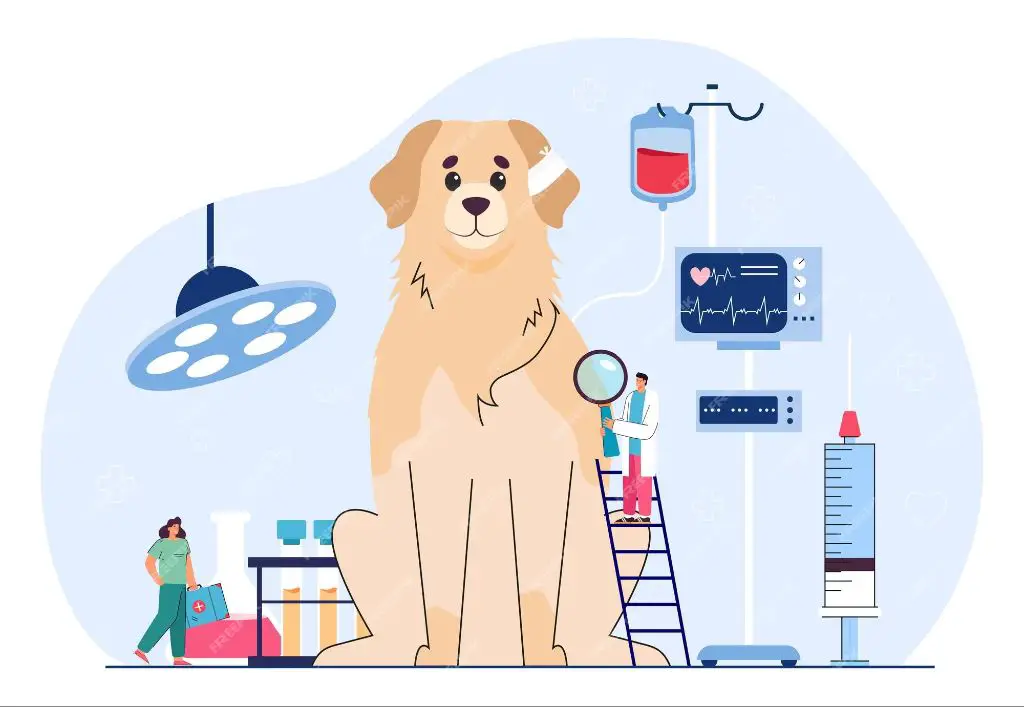Introduction
Cancer is the leading cause of death in dogs over the age of 10. Cancer refers to abnormal cell growth that leads to tumors or malignant growths. While cancer may occur in any part of a dog’s body, some of the most common types of dog cancer include skin cancer, breast cancer, bone cancer, blood cancer, and mouth cancer.
It’s estimated that about 1 in 3 dogs will develop cancer during their lifetime. Some breeds like Golden Retrievers, Boxers, and Bernese Mountain Dogs are at higher risk. While any dog can develop cancer, it primarily affects older dogs – the average age of diagnosis is between 6-10 years old. Early diagnosis and treatment is key for better prognosis.
Types of Dog Cancer
The most common types of cancer found in dogs include:
-
Lymphoma – This cancer affects the lymph nodes and lymphatic system. It is one of the most frequently diagnosed cancers in dogs.
-
Mast Cell Tumors – These tumors develop from mast cells in the body. Mast cells are involved in the body’s immune response. Mast cell tumors are common in dog’s skin and soft tissue.
-
Melanoma – This cancer begins in the pigment-producing cells known as melanocytes. Melanomas often develop in a dog’s mouth, lips, skin, and toes.
Other common cancers in dogs include osteosarcoma (bone cancer), hemangiosarcoma (cancer of blood vessel walls), and mammary gland tumors (breast cancer).
Stages of Cancer
Veterinarians use a staging system to categorize the progression of cancer in dogs. Determining the stage of cancer is important for prognosis and guides the course of treatment. There are several staging systems, but a commonly used one is the TNM system:
- T (Tumor): Refers to the primary tumor’s size and invasiveness. T1 is a small localized tumor, while T4 describes a large invasive tumor that has spread.
- N (Node): Indicates if and how far cancer has spread to nearby lymph nodes. N0 means it has not spread to nodes, while N2 means it has spread to distant nodes.
- M (Metastasis): Describes distant metastasis, or how far cancer has spread to other body parts. M0 means no metastasis, while M1 indicates spread.
Based on these TNM factors, cancer may be classified into stages such as:
- Stage I: Early localized cancer
- Stage II: Localized but larger tumor or spread to nearby nodes
- Stage III: Larger tumor and lymph node involvement
- Stage IV: Widespread metastasis
Staging provides key information about the dog’s overall prognosis and the appropriate treatment path. More advanced stages may require more aggressive treatment.
Symptoms
There are a number of symptoms to look out for that may indicate your dog has cancer. Some of the most common symptoms include:

Lumps or swellings: One of the most obvious signs of cancer is the presence of lumps or swellings on your dog’s body. These may be present on the skin or just under the skin. Lumps can vary in size and may be soft or firm to the touch. Any new lumps or swellings should be checked by a vet.
Abnormal bleeding or discharge: Unexplained bleeding or fluid discharge can also be an indicator of cancer. You may notice blood in your dog’s stool or urine. There could also be bleeding from the nose, mouth or genital area. Abnormal discharge may be coming from an opening or wound on the skin.
Changes in bowel habits: Some forms of cancer can lead to diarrhea, constipation, blood in the stool or straining to defecate. These are signs that something is not right with the digestive system.
Difficulty eating or swallowing: Tumors in the mouth, throat or neck can make it painful or difficult for a dog to chew or swallow food. You may notice your dog drooling more or dropping food from their mouth.
Weight loss: If cancer is present, you may notice your dog experiencing weight loss despite a normal or increased appetite. This happens because the cancer uses up calories.
Lethargy: Dog cancer can cause your dog to seem more tired or less energetic than normal. They may sleep more or be reluctant to exercise or play.
Keep an eye out for any of these common symptoms in your dog. Early detection leads to the best chance of successful treatment.
Diagnosis
Diagnosing cancer in dogs begins with a thorough physical exam by a veterinarian. The vet will check for lumps, bumps, or abnormalities that may indicate cancer. However, a biopsy is usually needed to confirm a cancer diagnosis.
Common diagnostic tests for cancer in dogs include:
- Biopsy – Removing a small sample of tissue and examining it under a microscope. This is the most definitive way to diagnose cancer.
- Imaging – X-rays, ultrasound, CT scan or MRI to look for tumors or abnormalities. Imaging helps determine the location, size and spread of cancer.
- Bloodwork – Testing blood for elevated white blood cells or abnormal cells which can indicate cancer.
- Lymph node aspiration – Removing cells from lymph nodes to check for cancerous cells.
These diagnostic tests allow veterinarians to determine the type of cancer, where it is located, if it has spread, and develop an appropriate treatment plan.
Treatment

Treatment for dog cancer depends on the type, location, and aggressiveness of the cancer. Some common treatment options include:
Surgery
Surgery is often the first line of treatment and can remove localized tumors or cancer growths. Surgery aims to fully remove the cancerous tissue with clear margins. For some cancers like osteosarcoma (bone cancer), amputation of the affected limb may be necessary.
Chemotherapy
Chemotherapy uses anti-cancer drugs to kill cancer cells and shrink tumors. It may be used alone or alongside other treatments like surgery and radiation. Chemotherapy can have significant side effects in dogs including gastrointestinal issues, appetite changes, and suppression of the immune system.
Radiation Therapy
Radiation directs high energy beams at the tumor to damage and kill cancer cells’ DNA. It allows precise targeting of the cancerous tissue while sparing surrounding healthy tissue. Radiation therapy requires specialized equipment and trained veterinary oncologists to deliver the treatments.
Combining surgery, chemotherapy, and radiation provides the most aggressive approach against many dog cancers. Your veterinarian will recommend the best treatment protocol based on your dog’s specific cancer diagnosis.
Prognosis
The prognosis for dog cancer depends on several factors, including the type of cancer, its location in the body, and the stage of the disease. Some forms of dog cancer have a better long-term outlook than others.
For example, certain skin cancers like mast cell tumors have a good prognosis when caught and treated early. But other types like hemangiosarcoma and osteosarcoma have overall lower survival rates, even with aggressive treatment.
The location of the cancer is also important for predicting outcome. Tumors that can be fully removed surgically, like skin cancers, tend to have better prognoses. Cancers that spread to other organs and bones are more difficult to control and lead to shorter survival times.
Staging of the cancer – how far it has advanced – greatly impacts prognosis. Localized cancers that have not spread have the best outlook. Higher stage cancers that have spread to multiple sites in the body are very serious and have a poorer prognosis.
Ask your veterinarian about the typical prognosis for the specific type and stage of cancer your dog has. They can provide statistics on average survival times and odds of achieving remission with treatment. With some cancers, dogs can live years past their diagnosis with proper care.
Prevention
There are steps pet owners can take to lower their dog’s chances of developing cancer. Preventative care from an early age is key.
Get your dog accustomed to tooth brushing and regular professional dental cleanings. Poor dental health is associated with oral cancer and can allow harmful bacteria into the bloodstream that may promote cancer growth elsewhere in the body.
Maintain your dog at a healthy weight. Obesity stresses the body, contributes to inflammation, and is linked to increased cancer risk. Work with your vet to determine an optimal weight for your dog’s breed and age, and adjust food portions accordingly.
Limit exposure to known environmental carcinogens. Avoid tobacco smoke, charred meats, pesticide-treated lawns, and other contaminants that could introduce cancer-causing compounds.
Talk to your vet about cancer screening tests that may detect disease in early, more treatable stages. Tests like chest x-rays, blood work, and dental exams can spot abnormalities for further evaluation.
Vaccinate your dog against infectious diseases that are associated with cancer, like rabies virus and papillomavirus.
Spay/neuter your dog before 6 months of age to protect against hormone-related cancers. Discuss the ideal timing with your vet.
Check your dog regularly for lumps, bumps, sores or changes that may indicate cancer. Early detection and treatment can significantly improve outcomes.
Quality of Life
Quality of life is an important consideration when managing dog cancer. As dogs enter the later stages of cancer, the goal of treatment often shifts from curing the cancer to prolonging life while maintaining comfort and happiness. Dog owners have difficult but compassionate decisions to make about pain management, palliative care, and end-of-life care.
Palliative care focuses on relieving pain, managing symptoms, and improving overall quality of life. Options may include pain medications, anti-nausea drugs, appetite stimulants, physical therapy, and alternative therapies like acupuncture. Work closely with your veterinarian to find the right combination to keep your dog as comfortable and content as possible.

As cancer progresses to an advanced stage, dog owners must decide when to transition from treatment to hospice-like end-of-life care. It is a highly personal decision based on factors like your dog’s pain levels, mobility, appetite, personality changes, and any other signs their quality of life is declining. Saying goodbye is difficult, but euthanasia can be the final act of love and kindness for a beloved dog at the end of their life.
Treating dog cancer is challenging emotionally and financially. But focusing on quality of life helps guide difficult decisions with your dog’s happiness and comfort as the top priorities. Work closely with your veterinarian and lean on pet cancer support groups as you navigate this journey with your cherished canine companion.
Conclusion
Dog cancer can be very aggressive and life-threatening if not caught early. The most aggressive types of canine cancer include osteosarcoma, hemangiosarcoma, lymphoma, and mast cell tumors. Osteosarcoma and hemangiosarcoma have a high rate of metastasis, while lymphoma and mast cell tumors tend to spread rapidly throughout the body.
Early detection is critical when dealing with aggressive cancers in dogs. Performing routine wellness checks and knowing your dog’s normal behavior can help identify warning signs like limping, swelling, or lumps under the skin. If caught early while still localized, aggressive cancers like osteosarcoma have a better prognosis with treatment. Working closely with your veterinarian and opting for regular screening tests can make a major difference in successfully treating cancer in dogs. While cancer can progress quickly in dogs, timely diagnosis and intervention can slow the spread of disease and extend a dog’s survival and quality of life.
